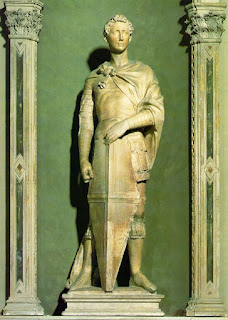In his tour of the Bargello, Florence's sculpture gallery, Edward Hutton had high praise for the work of Donatello and its unique contribution to Renaissance sculpture. Donatello's marble David, pictured below, is less famous than his bronze version, but Hutton regarded his St. George as his masterpiece.
Of Donatello’s life we know almost nothing. If we seek to learn something of him, it must be in his works, of which so many remain to us. We know, however, that he was the intimate friend of Brunellesco, and that it was with him he set out for Rome soon after this great and proud man had withdrawn from the contest with Ghiberti for the Baptistery gates. Donatello was to visit Rome again in later life, but on this first journey that he made with Brunellesco for the purpose of study, he must have become acquainted with what was left of antiquity in the Eternal City. It was too soon for that enthusiasm for antiquity, which later overwhelmed Italian art so disastrously, to have arisen. When Donatello returned about a year later to Florence to work for the Opera del Duomo, it is not any classic influence we find in his statues, but rather the study of nature, an extraordinary desire to express not beauty, scarcely ever that, but character. His work is strong, and often splendid, full of energy, movement, and conviction, but save now and then, as in the S. Croce Annunciation, for instance, it is not content with just beauty….(284)
 |
| Donatello: St. George |
So in the bronze David now in the Bargello we seem to see youth itself dreaming after the first victory of all the conquests to come, while a smile of half-conscious delight is passing from the lips; tyranny is dead…. (287)
But here in the Bargello we have enough of his work to enable us to divine something at least of his secret. And this seems to me to have been Donatello’s intention in the art of sculpture: his figures are like gestures of life, of the soul, sometimes involuntary and full of weariness, sometimes altogether joyful, but always the expression of a mood of the soul which is dumb, that in its agony or delight has in his work expressed itself by means of the body, so that though he never carves the body for its own sake, or for the sake of beauty, he is as faithful in his study of it for the sake of the truth, as he is in his study of those moods of the soul which through him seem for the first time to have found an utterance. (288)
###
Edward Hutton: Florence and Northern Tuscany with Genoa, second edition, London, 1908. Pp. 284-288.


No comments:
Post a Comment